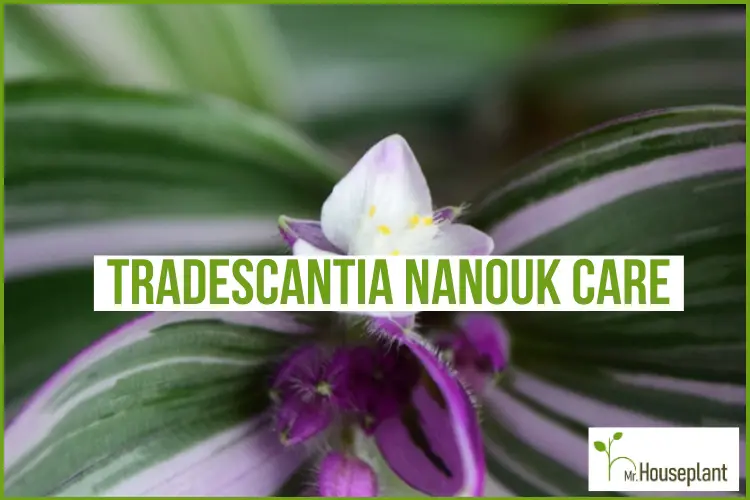
If you’re looking to add a splash of color to your indoor plant collection, Tradescantia Nanouk is the right plant for you. Keep reading for a complete plant care guide of Tradescantia Nanouk, that will teach you everything you need to grow this trendy and vigorous plant. And will teach you a few extra care tips.
| Botanical Name (Latin Name/Scientific Name): | Tradescantia albiflora ‘Nanouk’ |
| Common Name: | Tradescantia Nanouk, Fantasy Venice |
| Light: | Bright indirect light |
| Watering: | once the soil dries out to the bottom of the pot |
| Soil: | Well-draining potting mix |
| Repotting: | Once a year |
| Temperature: | between 65°F and 75°F (18°C and 24°C) |
| Humidity: | optimal between 25% and 50%, but adapts well to any humidity |
| Fertilizing: | Every 2 to 4 weeks with a high nitrogen fertilizer |
| Toxicity for Pets: | likely yes (dermatitis) |
| Toxicity for Humans: | likely no |
| Propagation: |
|
| Pruning: | Prune dead or diseased growth or when you want the plant to branch out |
Tradescantia Nanouk plant (commonly called Wandering Jew) is a cultivar that was patented in 2017, according to the United States Plant Patent USPP29711P2. Tradescantia plants originated in South America, but the Nanouk variant was developed in the Netherlands, in Sappemeer, in 2012. It was created through the cross-pollination of two Tradescantia Albiflora seedlings. This patented plant is well known by the common name Fantasy Venice.
Tradescantia Nanouk’s purple, pink, green and white foliage is decorative and eye-catching. Its flowers are three-petaled, small, delicate, and white. Nanouk’s captivating and vivid leaves attract people around the globe, and it is becoming an increasingly popular indoor plant. Fantasy Venice is a hardy and low-maintenance plant, and as such, it’s equally sought after by both experienced gardeners and beginners.
You don’t need to be a gardening veteran to grow Tradescantia Nanouk. With just a little bit of care, you can have a colorful and aesthetically pleasing houseplant.
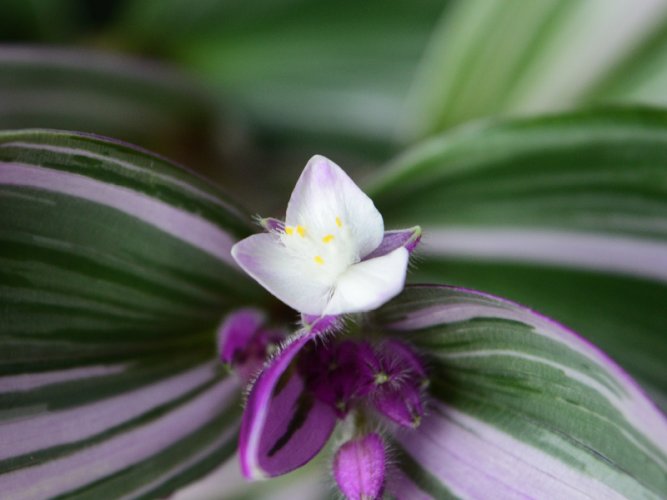
Nanouk flowers open up with enough indirect bright light
Types of Tradescantia Nanouk
Tradescantia Nanouk genus is rather large, and it comprises of 75 species, mainly native to subtropical and tropical regions in the Americas. They all look pretty similar, and it’s often not so easy to distinguish them. It takes careful observation and some skills to be able to correctly identify the Tradescantia variety.
Among many different varieties of Tradescantia plants, the most commonly kept as indoor plants are Tradescantia Zebrina, Tradescantia Fluminensis, and Tradescantia Pallida.
People sometimes confuse the Tradescantia Nanouk variety with some of her relatives, especially with the Tradescantia Fluminensis Tricolor. The best way to differentiate between Fluminensis and Nanouk is to take a closer look at leaves and vines. Nanouk is more compact, looks slightly sturdier, with thicker vines.
All Tradescantia Nanouk varieties are characterized by lush foliage, either with a solid color or with a combination of these four colors: pink, purple, white, and green according to Chicagobotanic.org.
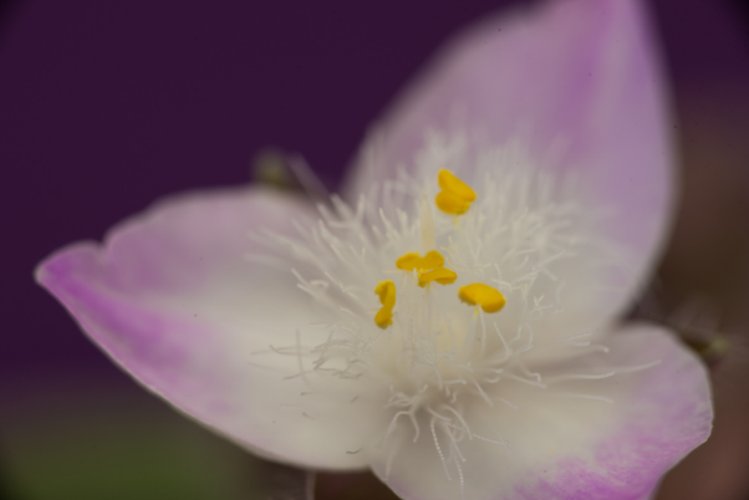
Good Tradescantia Nanouk care produces a colorful plant and pink white flowers
Tradescantia Nanouk Care – How Hard Is It
Tradescantia Nanouk care is in general easy, as long as you provide the plant with an adequate amount of light, good-quality potting mix, and proper watering. Make sure to avoid overwatering and exposing the plant to direct sunlight for too long as this can damage the plant. Tradescantia is also susceptible to certain pests and diseases, so keep an eye on possible spider mites infestation and fungus gnats.
Bright Indirect Light for Tradescantia Nanouk
| Minimal amount of light: | 3,000 lux (300 FC) |
| Optimal amount of light: | 5,000+ lux (500+ FC) |
| Direct sun tolerance: | 1-2 hours |
| Category: | Bright indirect light |
Tradescantia Albiflora Nanouk thrives in bright indirect sunlight. The minimal amount of light recommended for Tradescantia is 3,000 lux (300-foot candles), and the optimal amount of light is 5,000 lux (500 FC) and more. Nanouk can tolerate 1-2 hours of direct sun, and if you want to get the optimal flower production you should aim for 6-8 hours of bright indirect sunlight daily.
If the Nanouk Tradescantia Albiflora doesn’t get enough indirect light the leaves will turn green, instead of having the vibrant purple/pink shade. Some direct sun is beneficial, but make sure not to overdo it, since the leaves can get bleached or sunburned from too much direct sunlight. It’s important to find the right balance to get optimal Tradescantia plants growth and flower production.
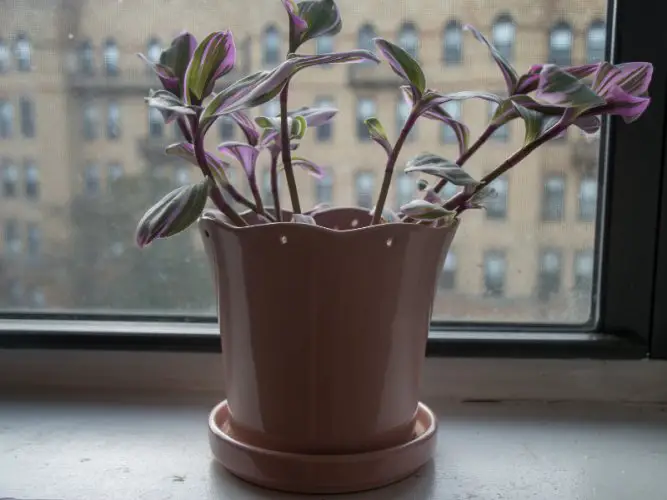
Tradescantia stems thriving with enough light. They like bright indirect sunlight
Watering for Tradescantia Nanouk
The golden rule for Tradescantia Nanouk watering frequency is to observe it and water only when the potting mix is dry completely. Watering shouldn’t follow a specific schedule, as houseplants require different watering frequencies depending on your home environment. It is important to avoid overwatering your plant, as it can lead to root rot and fungus gnats.
Make sure your container or pot has drainage holes so any excess water can be eliminated. Although Tradescantia Nanouk care is simple and it tolerates drought better than soggy soil, underwatering can also cause damage to the plant.
Best Soil for Tradescantia Nanouk
To make your own potting soil mix and do the best Tradescantia Nanouk care, you should use the below listed ingredients:
- 2 parts of all-purpose soil
- 1 part of orchid bark
- 1 part of perlite
Tradescantia Nanouk soil should be well-draining soil, so any store-bought potting mix needs to be amended with bark, perlite, pumice, gritty sand, vermiculite, or other amendments. If you don’t have orchid bark or perlite at the moment, you can use other listed amendments instead.
By amending the soil, you will make it better draining. This will prevent the soil from getting too soggy and susceptible to root rot.
Also, adding amendments with larger particles is vital because they create macro-pores containing oxygen. Having oxygen-rich soil lowers the chances of root rot and nutritional deficiencies.
The lack of oxygen in soil can affect plant physiological processes, which means that plants can’t absorb nutrients properly. Oxygen-deprived plants will also have issues with optimal water uptake, so it’s important to add the amendments in order to maintain good oxygen levels.
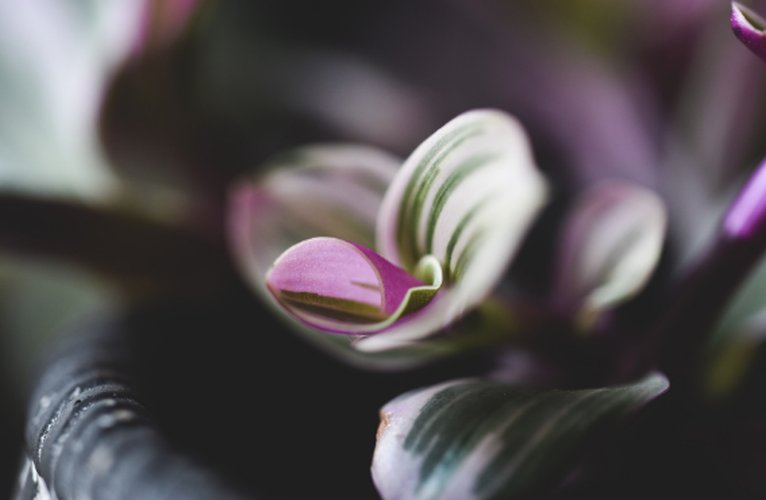
Balanced mix of potting soil in your Tradescantia Nanouk care routine leads to new leaf growth
How to Repot Tradescantia Nanouk
The steps to repot your Tradescantia Nanouk are listed below:
- Use a container or a pot that is one size larger than the one you’re currently using
- Fill the pot one-third with fresh, well draining soil
- Take out the plant from the pot and loosen the rootball
- Look at the roots and remove dead and rotting roots if you notice them
- Place your plant in the middle of the new pot
- Fill in the sides of the pot with soil
- Firmly press the potting soil and water it
Make sure that your new pot has drainage holes since Tradescantia does not like soggy soil. While it’s possible to grow it in a pot without holes, it’s not recommended for beginners.
Since Tradescantia Nanouk is a vigorous grower, you will need to repot it once a year, or when it has outgrown its pot. You will notice that your Nanouk has outgrown the pot if you gently pull the entire plant out and see mostly intertwined roots and not much soil. You can also check if the roots are poking out of the bottom of the container. This is a sign that you should repot your plant.
Repotting is crucial for plant health because the old, oxygen-deprived, compacted soil is removed in this process. If you don’t repot it once a year, gradually the soil will become compacted and deficient in nutrients, and the roots will not be getting enough oxygen.
Tradescantia Nanouk Fertilizing
If you repot your Tradescantia Nanouk annually, you don’t need to fertilize it. When you repot your plant, it will get new nutrients necessary for proper growth from fresh soil. However, if you would like to fertilize Tradescantia Nanouk, you can do it, provided you follow the instructions on the fertilizer packaging. Use a houseplant fertilizer, diluted to half recommended strength.
The best time to fertilize your plants is during the active growing season. In that way, the plants can put all the nutrients to good use. Using a houseplant fertilizer on your plant outside of their growing season can do more harm than good since they will not be able to use the nutrients and they will build up in the soil. This can cause fertilizer burn. This is also why you should use the houseplant fertilizer diluted to half recommended strength.
Temperature for Tradescantia Nanouk
The optimal temperature for Tradescantia Nanouk is between 65°F and 75°F (18°C and 24°C), according to professor Bodie V. Pennisi from the University of Georgia Extension. Tradescantia Nanouk can tolerate as low as 50°F (10°C), below which it will get damaged. This plant is sensitive to frost and extreme heat, so it is best to stay within the optimal temperature range to avoid leaf damage.
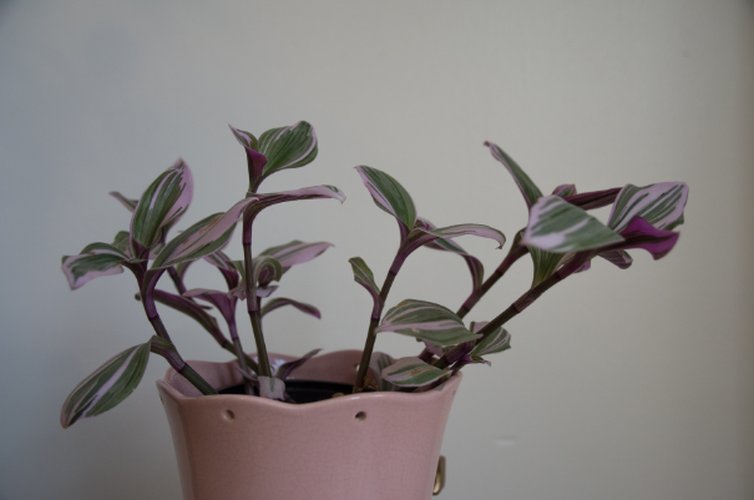
Proper temperature as an important factor in Tradescantia Nanouk care, leads to a healthy plant
Tradescantia Nanouk Humidity
The optimal humidity for Tradescantia Nanouk is between 25-50%, according to professor Bodie V. Pennisi from the University of Georgia Extension. Even though the Nanouk variety, like other Tradescantia plants, prefers humid growing conditions, it will adapt to any humidity without problems.
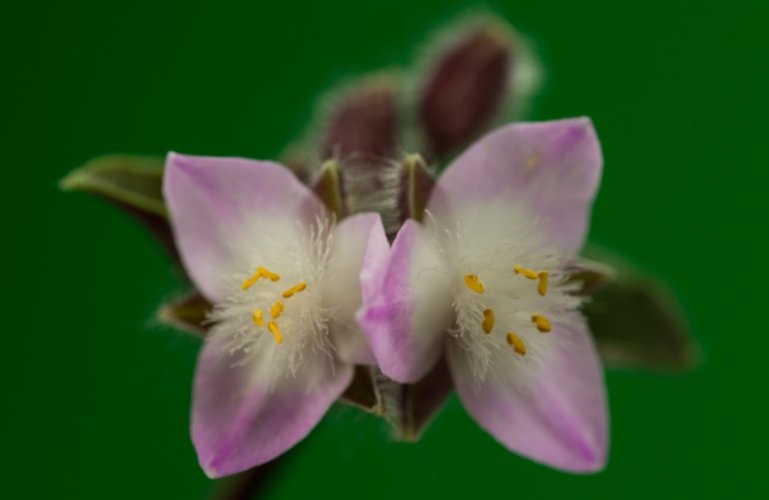
Tradescantia Nanouk under proper humidity with pink and white flowers
Toxicity To Pets
Tradescantia Nanouk plant is likely toxic to cats and dogs. American Society For The Prevention Of Cruelty To Animals (ASPCA) lists a plant from the same genus Tradescantia Flumeninsis as toxic to pets. If you have pets, make sure to keep them away from this plant, as they could get dermatitis.
Toxicity To Humans
Tradescantia Nanouk plant should be safe for humans. Several plants from the same genus are considered safe for humans, according to the California Poison Control System. Those plants are Tradescantia Multiflora, Tradescantia Reginae and Tradescantia Navicularis. Keep in mind that even plants that are safe for humans can cause vomiting if ingested.
Tradescantia Nanouk Pruning
There are several reasons to prune Tradescantia Nanouk, that are listed below:
- if you want the plant to branch out, prune it, and it will branch out below the cut
- if it becomes too big for your liking
- if you notice any sick, diseased or dead parts, which need to be removed to prevent the disease from spreading
Tradescantia Nanouk Propagation
To propagate Tradescantia Nanouk you can use one of the three propagation methods listed below:
- stem cutting in water
- stem cutting in soil
- division
The easiest and most popular method is propagation via stem cuttings in water. To propagate a plant using stem cuttings method, you’ll need to:
- Take a few inches long stem cutting of Tradescantia Nanouk using scissors. You should cut just below a leaf node
- To increase chances of success, cut several stems
- Place the cuttings into a container with fresh water, make sure that at least 2 nodes are in water and that the leaves are out of the water
- Make sure the cuttings gets bright indirect sunlight in your home
- Replace the water once a week
- Wait for new growth of roots
- In about 3-4 weeks the roots reach about an inch or two you can transfer the stem from water into soil
Common Growing Problems With Tradescantia Nanouk
Although Tradescantia Nanouk is a generally resilient plant, it is susceptible to certain problems that can be prevented and remedied with just a little extra plant care.
Root Rot
Tradescantia Nanouk is susceptible to root rot when it’s overwatered. Symptoms of it include yellow and wilting foliage. The roots will be soft, smelly and mushy. The leaves will sometimes turn red or dull green as they wither. If the soil looks waterlogged and overly moist you should stop watering the plant until the first two inches of soil have dried out. Take the Nanouk Tradescantia plant out of the pot and inspect the roots. Remove the rotting ones and repot into a new, well draining soil.
It’s always better to prevent root rot since it’s quite difficult to treat once it develops. The best way to prevent it is to increase the amount of light and add amendments to the soil to provide more oxygen for the roots. It is also important to be careful not to water too frequently, but only once the soil has reached a certain level of dryness.
Loss of Leaf Color
If your Tradescantia Nanouk care doesn’t include enough bright indirect light, its leaves will lose their purplish-pink color and turn green. If this happens, you should move your plant closer to the windows, into an area that has more light, so it can restore its vivid colors. Keep in mind that Tradescantia prefers bright indirect light.
Leaves dying
If the leaves of your Nanouk plant are dying or turning yellow, there are multiple possible culprits listed below:
- Normal leaf loss – older leaves die as new ones grow
- Overwatering
- Underwatering
- Lack of enough light
- Nutrient deficiency
- Pests and diseases
Pests & Other Problems
Spider mites are the most common pest issue when it comes to Tradescantia Nanouk care. They prefer a dry and warm environment with low humidity. The best way to prevent spider mites is to make sure that the area around your indoor plants has enough humidity.
Small yellow spots on the foliage and webbing on the leaves are reliable indicators that you’re dealing with spider mites. Neem oil is a great remedy for spider mites infestation, as well as for other pests. If you catch the infestation in its early phase, you can also use a high-powered water stream to remove the mites from the leaves.
There is also a risk of fungus gnats, which won’t damage the plant but can be very annoying. To reduce the chances of these pests, let the top two inches of soil dry out before watering. If that doesn’t help and you’re wondering how to get rid of fungus gnats in houseplants, check out the linked article.
Tradescantia Nanouk FAQs
Is Tradescantia Nanouk Easy to Care For?
Yes, Tradescantia Nanouk is easy to care for if you provide proper light and proper watering. It’s not a tricky plant to grow, and even gardening rookies can grow it successfully.
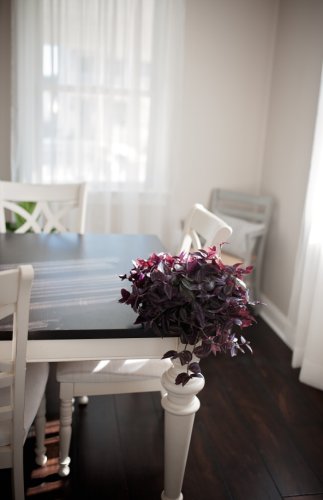
Tradescantia Nanouk care is easy, just look at these densely packed stems
How Fast Does Tradescantia Nanouk Grow?
Nanouk is a fast grower and if you provide the plant with everything it needs it will flourish fast.
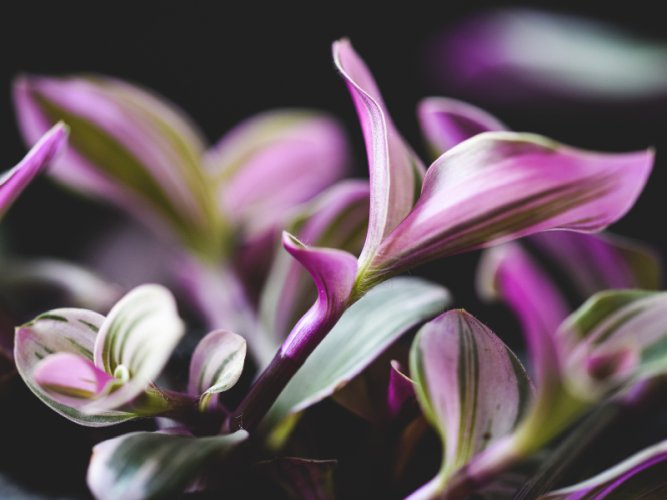
Tradescantia Nanouk foliage flaunting their colors and flourishing in the optimal growing conditions
Can Tradescantia Nanouk Grow Indoors?
Yes, Tradescantia Nanouk can grow indoors since it’s a houseplant. If the temperature indoors is good enough for humans, it’s good enough for Tradescantia Nanouk plants.
Can Tradescantia Nanouk Grow Outdoors?
Yes, Tradescantia Nanouk can grow outdoors. All plants are outdoor plants, we just brought them indoors. In case you want to grow your Nanouk plant outdoors make sure it doesn’t get too much direct sun (no more than 1-2 hours of direct sun). Also, you will need to water it more frequently. Higher exposure to light and the wind will dry out the plant and the soil much faster than indoors.
Another thing to consider is the temperature. According to Agraria.org Fantasy Venice doesn’t tolerate frost and temperatures lower than 50°F (10°C), so if you live in a colder climate, it’s better to keep it as an indoor plant.
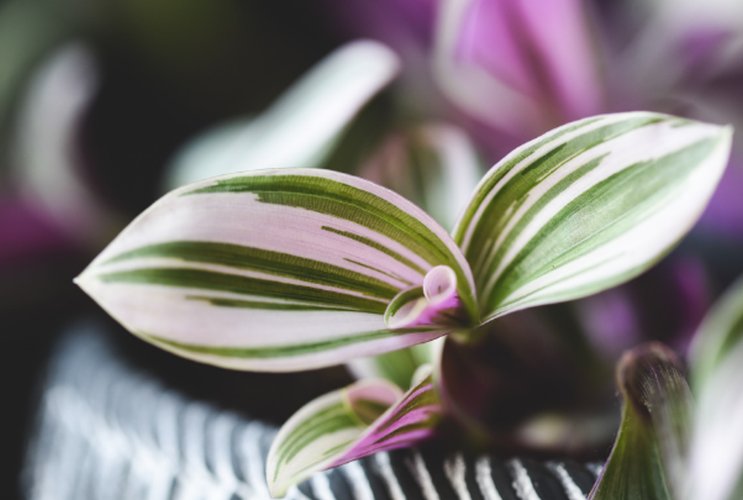
Tradescantia Nanouk is toxic to cats and dogs
Where Can I Buy Tradescantia Nanouk?
You can buy Tradescantia Nanouk plants on Amazon or Ebay through this link.
I hope you’ve learned everything about care for Tradescantia Nanouk plants and have picked up a few tips. If you have any questions, let me know in the comments below.
Yours Truly,

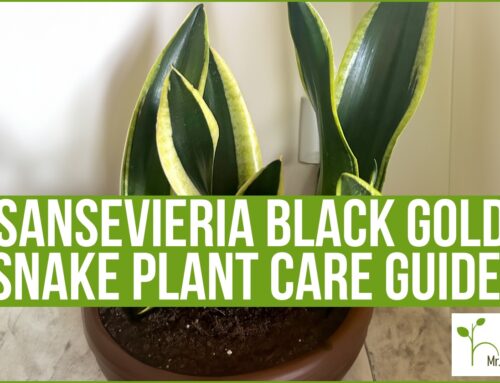
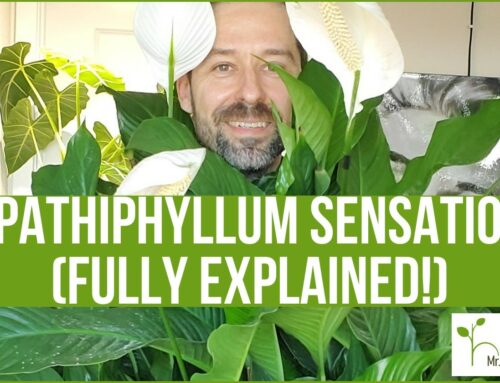
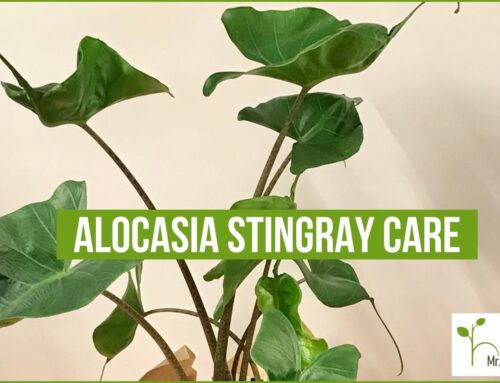


I love mine– it’s so unique among my other plants, but I can’t seem to make it happy. The leaves are great colors and it’s growing (after repotting it to a pot with better drainage and succulent soil after a bout with fungus gnats), but the leaves are still wilty. Ideas?
Hi Anna, I would have to see a photo to be able to advise, but in general if the leaves are green and healthy, and the plant is growing well, it doesn’t sound like a reason for concern 🙂
I often get messages from concerned owners with photos of plants that look perfectly normal :) From what you say, it doesn’t seem there is anything wrong with it. If you would like to send me photos to take a look, to make sure it’s fine, you can do so through this link: https://www.mrhouseplant.com/recommends/plant-questions/